




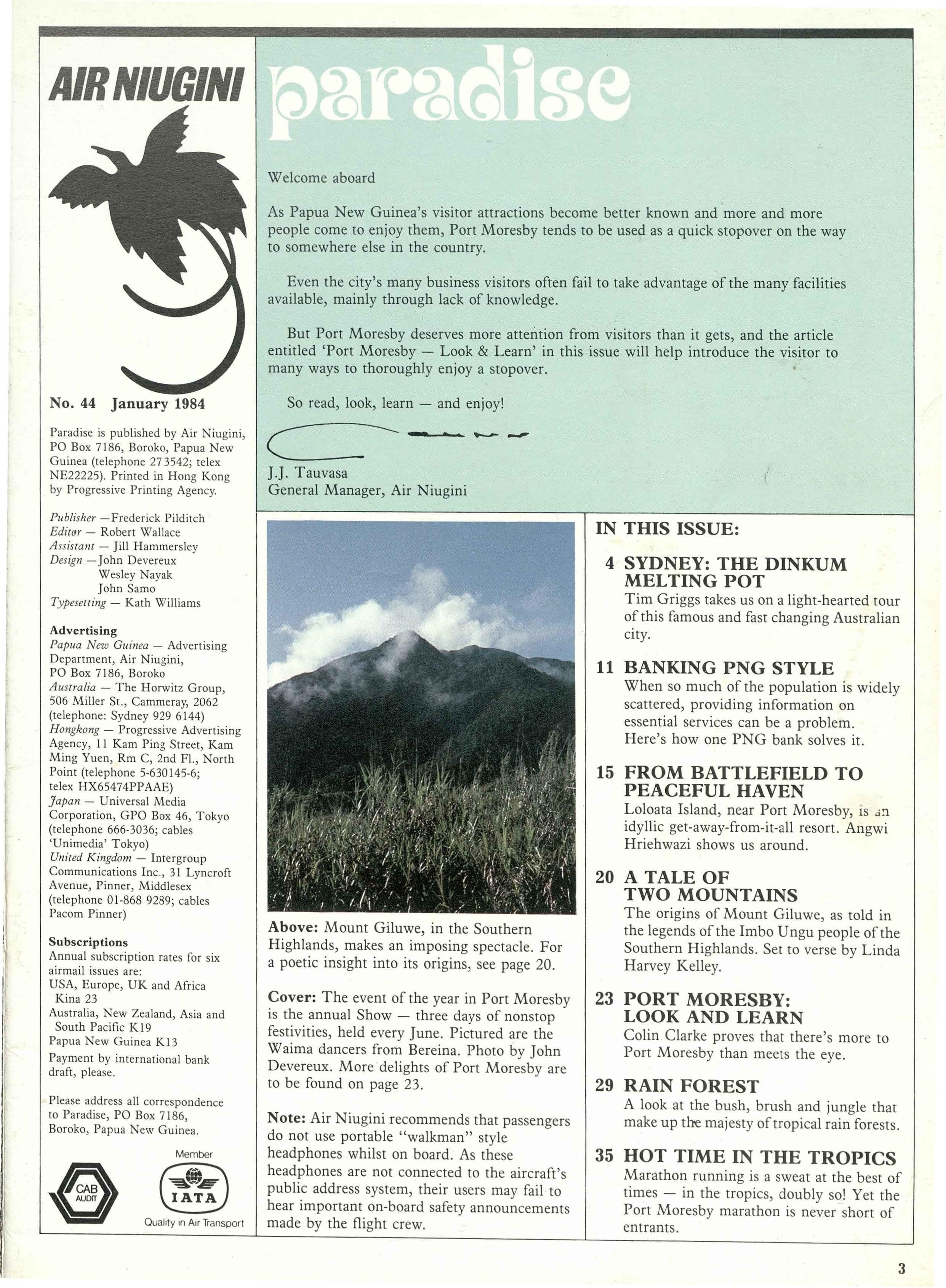
Paradise is published by Air Niugini, PO Box 7186, Boroko, Papua New Guinea (telephone 27 3542; telex NE22225). Printed in Hong Kong by Progressive Printing Agency.
Publisher -Frederick Pilditch •
Editor - Robert Wallace
Assiscant - Jill Hammersley
Design - John Devereux
Wesley Nayak
John Samo
Typeseuing - Kath Williams
Advertising Papua New Guinea - Advertising Department, Air Niugini, PO Box 7186, Boroko
Australia - The Horwitz Group, 506 Miller St., Cammeray, 2062 (telephone: Sydney 929 6144) Hongkong - Progressive Advertising Agency, 11 Kam Ping Street, Kam Ming Yuen, Rm C, 2nd FI., North Point (telephone 5-630145-6; telex HX654 74PPAAE)
Japan - Universal Media Corporation, GPO Box 46, Tokyo (telephone 666-3036; cables 'Unimedia' Tokyo)
United Kingdom - Intergroup Communications Inc., 31 Lyncroft Avenue, Pinner, Middlesex (telephone 01-868 9289; cables Pacom Pinner)
Subscriptions
Annual subscription rates for six airmail issues are:
USA, Europe, UK and Africa Kina 23
Australia, New Zealand, Asia and South Pacific K 19 Papua New Guinea Kl3 Payment by international bank draft, please.
Please address all correspondence to Paradise, PO Box 7186, Boroko, Papua New Guinea.
As Papua New Guinea's visitor attractions become better known and more and more people come to enjoy them, Port Moresby tends to be used as a quick stopover on the way to somewhere else in the country.
Even the city's many business visitors often fail to take advantage of the many facilities available, mainly through lack of knowledge.
But Port Moresby deserves more attention from visitors than it gets, and the article entitled 'Port Moresby - Look & Learn' in this issue will help introduce the visitor to many ways to thoroughly enjoy a stopover. •
So read, look, learn - and enjoy!
J.J. Tauvasa General Manager, Air Niugini
4
Tim Griggs takes us on a light-hearted tour of this famous and fast changing Australian city.
When so much of the population is widely scattered, providing information on essential services can be a problem. Here's how one PNG bank solves it.
Loloata Island, near Port Moresby, is a!1 idyllic get-away-from-it-all resort. Angwi Hriehwazi shows us around.
Above: Mount Giluwe, in the Southern Highlands, makes an imposing spectacle. For a poetic insight into its origins, see page 20.
Cover: The event of the year in Port Moresby is the annual Show - three days of nonstop festivities, held every June. Pictured are the Waima dancers from Bereina. Photo by John Devereux. More delights of Port Moresby are to be found on page 23.
Note: Air Niugini recommends that passengers do not use portable "walkman" style headphones whilst on board. As these headphones are not connected to the aircraft's public address system, their users may fail to hear important on-board safety announcements made by the flight crew.
The origins of Mount Giluwe, as told in the legends of the Imbo Ungu people of the Southern Highlands. Set to verse by Linda Harvey Kelley.
Colin Clarke proves that there's more to Port Moresby than meets the eye.
A look at the bush, brush and jungle that make up the majesty of tropical rain forests.
Marathon running is a sweat at the best of times - in the tropics, doubly so! Yet the Port Moresby marathon is never short of entrants.


intending to find a quiet bar where I could read my paper and plan my next move. The taxi-driver was alifornian; the barman was erman; the waitre s a stunning Filipina; and in the corner two trim office girls were chatting in Cantonese.
I opened the paper. On one page along it was advertising Malaysian, Indone ian, wiss, French, Japane e, reek, Mexican and Chinese re taurants. or a mention anywhere of beef, damper or witchetty grubs.
I followed this up later with a check through the restaurant section of ydney's Yellow Pages directory, and found the cuisine of 43 different cultures represented. Among these were Arabian, Balinese, Mongolian, ri Lankan, candinavian, and some formidable combinations like Australian-Italian.
Back to the newspaper. Flip a page and there's a gypsy cure for indigestion, notice of an upcoming season of Japanese films, and adverts for half-adozen martial arts academies, which will teach you how to kick people in the ear in Korean.
Another page-turn and you are being invited to have your fetishe catered for by exotic ladies from far away (presumably the farther the better) and to have your bondage fantasies dealt with by Hawaiian beauties; all credit cards welcome.
It began to dawn on me that this city of three million people, always a vigorous and exciting place to be, was rapidly developing into something very much more than that. With nearly a million Sydneysiders coming from overseas, the tapestry of the city's life is taking on a richness unmatched anywhere in the world.
Some communities, of course, have had their roots down in Australia for years. Sydney has one of the largest Greek populations outside Athens. Greeks - together with Italians and other European group - have long been making their contribution to the diversity of Sydney life: just have a look at the delicatessens and pizzerias.
The Chinese too, with their infallible nose for business,

"Yes dear, he's an Australian too"
have roots in Australia going back to the goldrush of the 1850s. Sydney has its Chinatown, naturally, but then every hamlet bigger than Tollpuddlein-the-Mire has one of those.
No, it is not the presence of people with these cultural backgrounds which is surprising. What is new is the sudden influx of a colourful tide of new migrants from Asia, South America and the Pacific Islands, among other places.
The caricature Anglo-Saxon Aus'sie - bronzed, seven feet tall, cracking stubbies, eating Vegemite sandwiches and smelling faintly of sheep - may never have existed at all. Certainly he is not to be found in Sydney, where an Australian citizen might very well be only five-feet-two, practise Buddhism and speak Vietnamese in his moments of relaxation.
Make no mistake, taken overall Australia is still an Anglo-Saxon nation; about a third of all migrants still come from the UK or Eire. What is extraordinary is that two-thirds do not.
The reasons for this are complex. Top of the list is the collapse of the White Australia policy, which crumbled throughout the seventies. This collapse was itself a recognition of Australia's move towards Asia as the obvious economic area to which it should be allied, just as Britain was turning towards Europe. Australia was involved in the Vietnam War, which Britain was not, and Australia's economy was booming, which Britain's (emphatically) was not. Entry requirements were tightened in both directions, and eased between Australia and Asia.
Quite suddenly, Australia began to see itself as an AsianPacific nation and notdefinitely not! - as some latterday outpost of Empire. Britain was no longer 'home' to Australians, even those who had been born there.
Now this hasn't come about without a certain personality crisis for Australia. Many AusC 0 -;: f t, :, £ sies cling stubbornly to the old ties. The British Royal Family gets massive coverage in the press, for example; which must confuse newcomers from Para-
Signs of the times: the ethnic visual presence makes a colourful impact on the changing urban scene
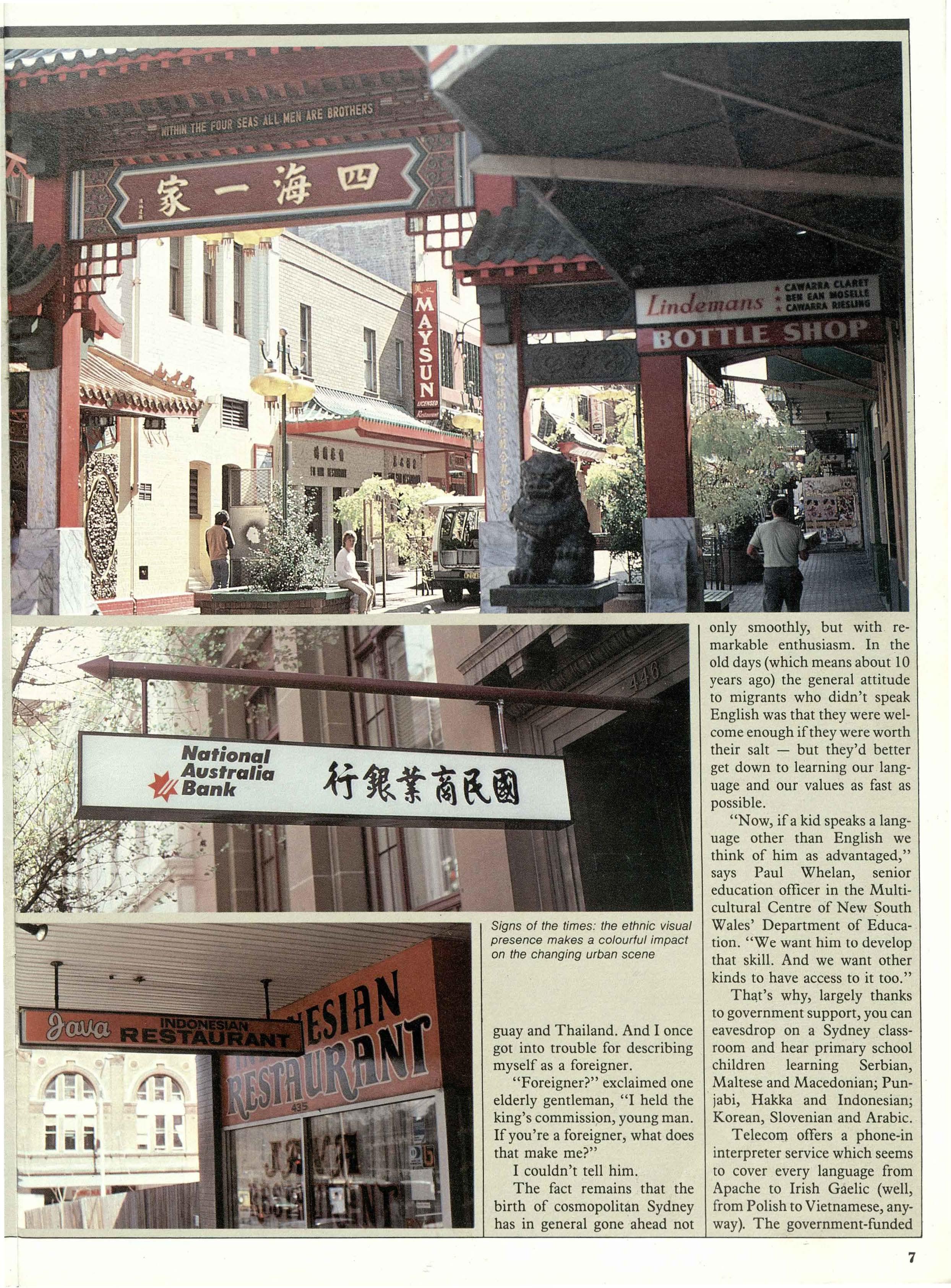
guay and Thailand. And I once got into trouble for describing myself as a foreigner.
"Foreigner?" exclaimed one elderly gentleman, "I held the king's commissipn, young man. If you're a foreigner, what does that make me?"
I couldn't t~ll him.
The fact remains that the birth of cosmopolitan Sydney has in general gone ahead not
only smoothly, but with remarkable enthusiasm. In the old days (which means about 10 years ago) the general attitude to migrants who didn't speak English was that they were welcome enough if they were worth their salt - but they'd better get down to learning our language and our values as fast as possible.
"Now, if a kid speaks a language other than English we think of him as advantaged," says Paul Whelan, senior education officer in the Multicultural Centre of New South Wales' Department of Education. "We want him to develop that skill. And we want other kinds to have access to it too."
That's why, largely thanks to government support, you can eavesdrop on a Sydney classroom and hear primary school children learning Serbian, Maltese and Macedonian; Pun• jabi, Hakka and Indonesian; Korean, Slovenian and Arabic.
Telecom offers a phone-in interpreter service which seems to cover every language from Apache to Irish Gaelic (well, from Polish to Vietnamese, anyway). The government-funded

y, this one is Leban above: newsagent Frank
does a brisk trade in foreign newspapers. In his shop alone there are papers in at least ten languages
Special Broadcasting Service puts out an ethnic radio station in Sydney which broadcasts in 53 languages, and a multicultural TV channel which has films, features and news from all over the world.
"Let's face it," says Paul Whelan, "if we aren't Aboriginal, we're all migrants - whether first generation or seventh."
Where there's language, there's culture. Even the most casual visitor to Sydney is unfortunate if he doesn't stumble across some ethnic event or other. Every week or so something is happening.
Maybe the Chinese are having a dragon dance to welcome their New Year. Or the Greek community will take over a Sydney park, and at the drop of a bazouki will be handing out the dolmades. If it's October, the Germans will be found staging an Oktoberfest complete with steins and lederhosen. Or if it's August, Sydney's 10,000 or so Hungarians will gather to celebrate St Stephen's Day, when they say nice things about freedom and nasty things about Russians. The Latin American Cultural Cooperative might be getting a few amigos together for a swift fiesta, as they did recently for their Festival de! Sol. There are scores of community cultural groups in Sydney. Large-scale multicultural extravaganzas are becoming a regular feature of Sydney's life too.
In June each year the Shell National Folkloric. Festival brings together hundreds of ethnic groups for days of dance
and song at the Opera House. Many of the groups rehearse all year for the event. The Festival of Sydney includes an increasing m.1mber of multicultural elements every year. And the State Premier's Department coordinates an annual statewide spe\;tacular called Carnivale which features parades, dances, fairs, film, theatre and all sorts of other junketing in the streets and parks - much of it in Sydney itself. "You would have to go to an Israeli kibbutz to find as many people from as many different cultures grouped together in one place as you will find today in Sydney," says Carnivale organiser Joan Simms. "I doubt if even the big American cities can claim the same kind of mix."
Another government officer puts it this way: "If we can get to the point where everyone, no matter what his background, knows he is welcome and knows he can make a contribution, then we will be making Sydney into the kind of place that I at least would like to stay in for the rest of my life."
Fings definitely ain't what they used to be in Sydney, cobber. They're a darn sight better.
Air Niugini flies from Port Moresby to Sydney 3 times every week.

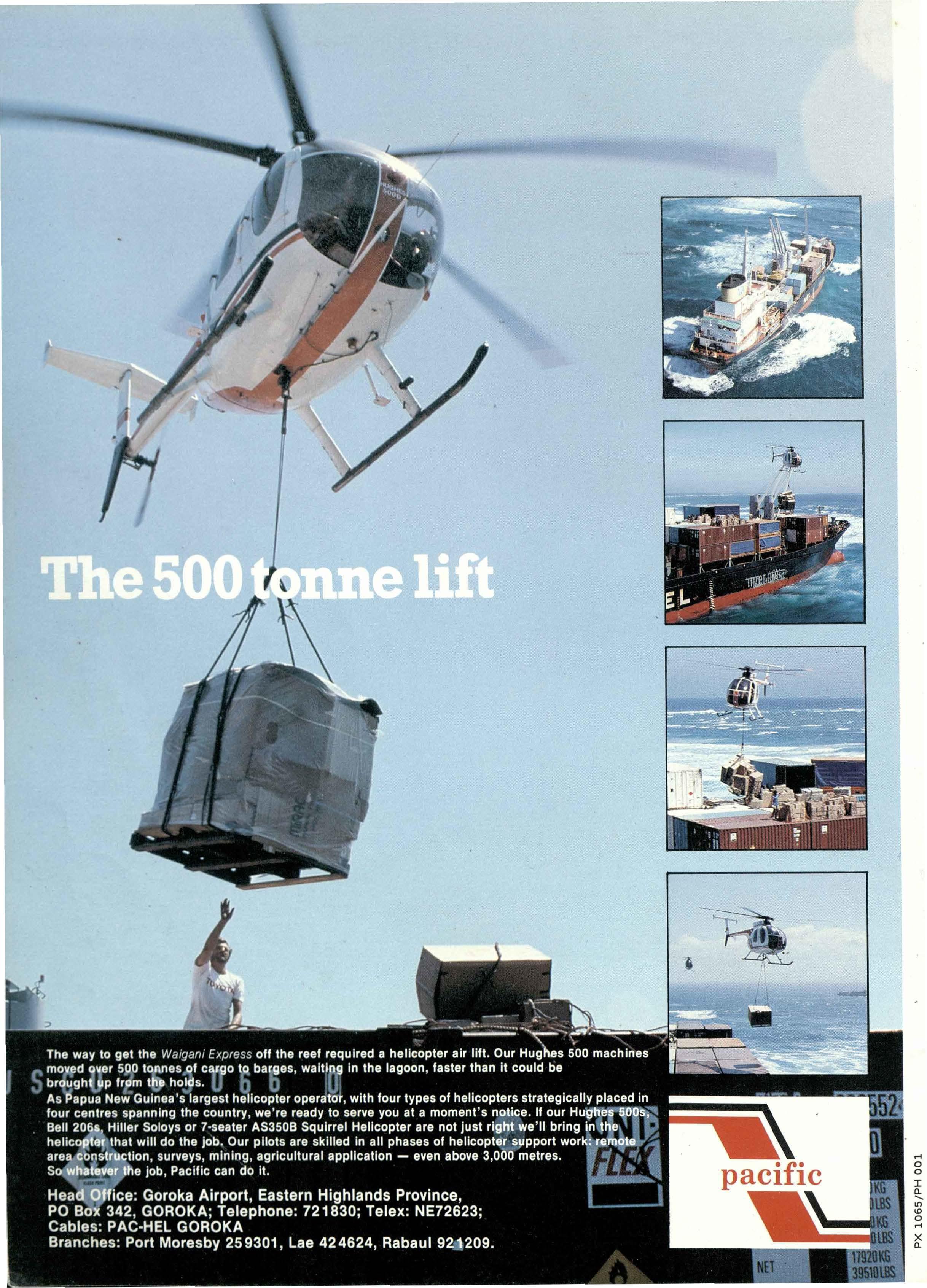
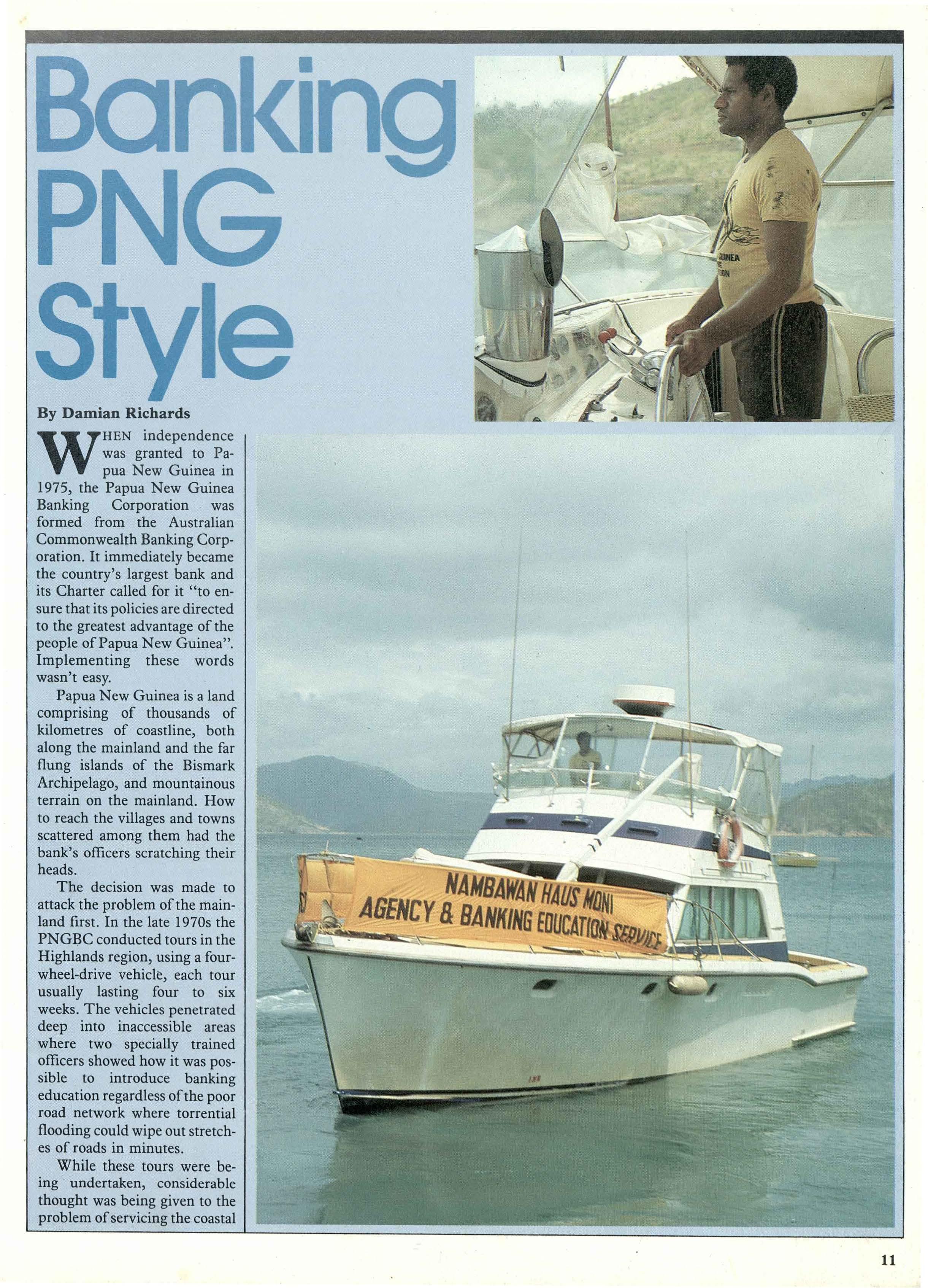
By Damian Richards
WHEN
independence was granted to Papua New Guinea in 1975, the Papua New Guinea Banking Corporation was formed from the Australian Commonwealth Banking Corporation. It immediately became the country's largest bank and its Charter called for it "to ensure that its policies are directed to the greatest advantage of the people of Papua New Guinea". Implementing these words wasn't easy.
Papua New Guinea is a land comprising of thousands of kilometres of coastline, both along the mainland and the far flung islands of the Bismark Archipelago, and mountainous terrain on the mainland. How to reach the villages and towns scattered among them had the bank's officers scratching their heads.
The decision was made to attack the problem of the mainland first. In the late 1970s the PNGBC conducted tours in the Highlands region, using a fourwheel-drive vehicle, each tour usually lasting four to six weeks. The vehicles penetrated deep into inaccessible areas where two specially trained officers showed how it was possible to introduce banking education regardless of the poor road network where torrential flooding could wipe out stretches of roads in minutes.
While these tours were being undertaken, considerable thought was being given to the problem of servicing the coastal
areas where, like the Highlands, the villages had little or no understanding of the banking system. There was only one way for the bank to meet these needs: In February of 1980 approval was given for the purchase ofa suitable motor vessel.
One was found in Sydney - a 13 metre motor cruiser built in 1973 by Halvarsen Morson and Gowland.
For the men who had made the decision to purchase Narnbawan, as the vessel was named, the obligations of the Charter were well on the way to being met. Those frightening logistics of the early days where lesser people would have pushed the relevant sections of the Charter into the too hard file had at last become reality.
The rationale behind the purchase was that Papua New Guinea was a new nation and

the people needed guidance on what money and the banking system meant to them. It was necessary to explain the interrelationship of the individual, the village and the country in financial terms. In many cases it was necessary to explain that money wasn't something to be collected and buried in the ground.
The first Narnbawan undertook four voyages calling on 4 7 points en route where the specially trained officers brought banking education to an audience of 7460 Papua New Guineans. Having proved the viability of reaching the people by sea it was decided to replace the original Nambawan with a vessel designed specifically for the bank's needs which included a shallow draft for navigation of inland waterways, extended periods at sea and a high stand-
ard of accommodation for crew. Eventually it was decided to purchase a Grand Banks 42 which was well known for its seaworthiness.
In March 1982 the new Nam bawan was commissioned and since then she has visited 54 points on her voyages and introduced banking to more than 30,000 people. The new Nambawan, in fact, reached more villages and people in its first six months of operation than did the original Nambawan in its two years of service. -On its latest trip it had 30 points of call and some 15,000 people were introduced to banking. Villages sometimes had up to a thousand people at the presentation.
The crew, a skipper and three banking education officers, all Papua New Guineans, need to be resourceful. On a
recent trip to the Trobriand Islands a stainless steel rod in the heat exchanger broke through corrosion. Using some lateral thinking, the skipper managed to find a local engineer and together they manufactured a brass rod which held until the Nambawan returned to Port Moresby.
Crew also participate in one of Papua New Guinea's favourite past-times, fishing. It not only supplements the diet but prpvides some light relief on the long sea legs around the islands. Sometimes the crew get more than they bargain :-- once for a 1201b sailfish was unexpectedly hooked. After some exciting angling it was eventually landed.
The function of both Nambawan and the off-road vehicle is not to open accounts, take deposits or check savings
accounts. Their task is entirely· educational, which means of course that the services are nonprofit making. The specially trained staff carry with· them films (and a portable generator), pamphlets and other educational aids which are set up at the village. Over a two to three hour session the concept of banking is explained.
Over the years the detail of the presentation has been developed to take into account the level of awareness factor of the villagers in order to ensure the points made are understood. The presentation has to be flexible. The officers are frequently faced with villagers whose main la·nguageis their pies tok ("place talk") - the dialect of their particular area.
To overcome this, the presentations are usually conducted in Pidgin and are designed to

educate through participation.
The two basic principles underlying the programme are the need to bring knowledge and understanding of the banking system to all Papua New Guineans and to show people that money can be invested safely and wisely within the banking system.
The isolated dweller has been reached and the Charter obligations fulfilled in real Papua New Guinean fashion.~
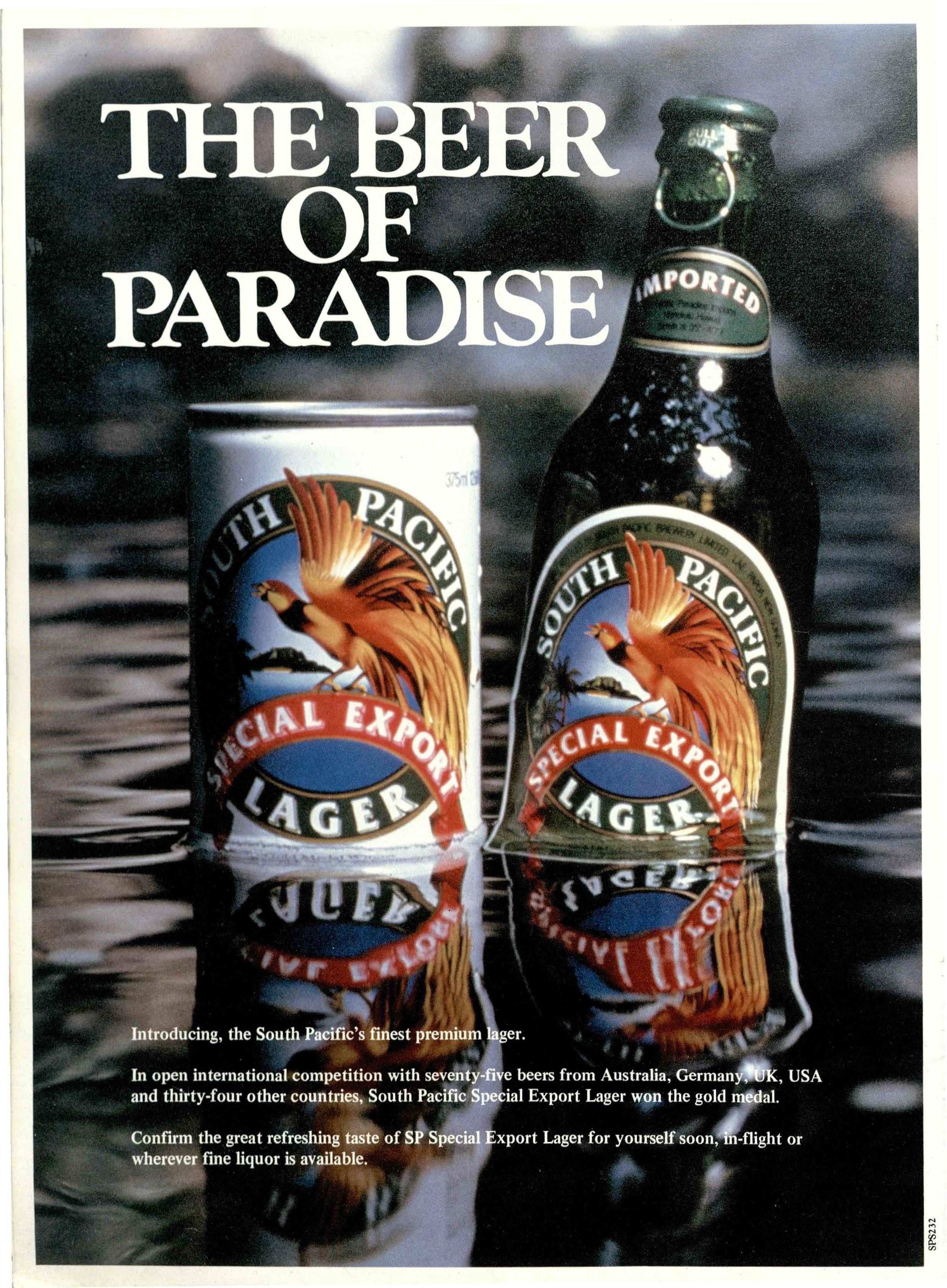

Story by Angwi Hriehwazi, photos by John Gough
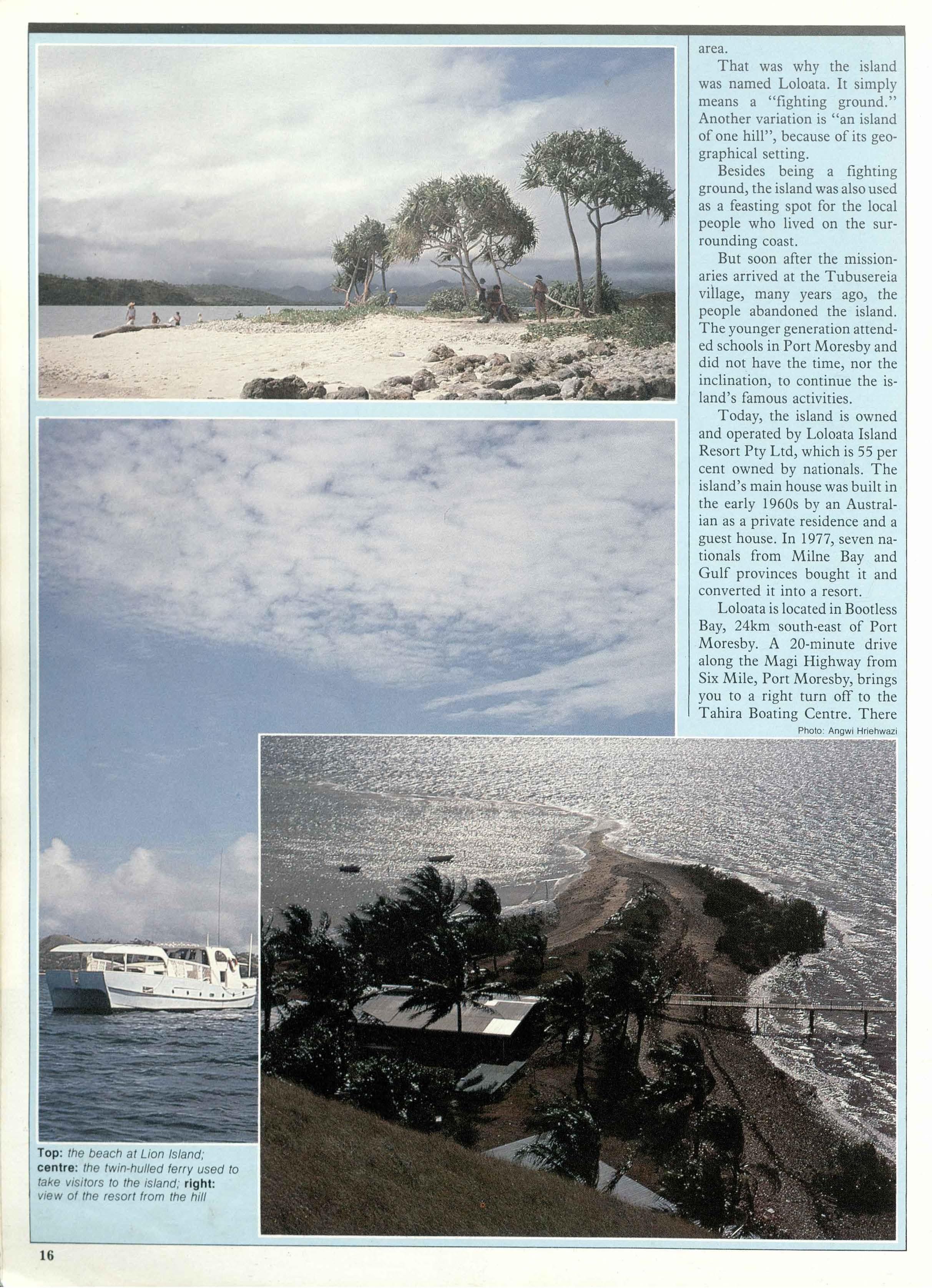
area.
That was why the island was named Loloata. It simply means a "fighting ground." Another variation is "an island of one hill", because of its geographical setting.
Besides being a fighting ground, the island was also used as a feasting spot for the local people who lived on the surrounding coast.
But soon after the missionaries arrived at the Tubusereia village, many years ago, the people abandoned the island. The younger generation attended schools in Port Moresby and did not have the time, nor the inclination, to continue the island's famous activities.
Today, the island is owned and operated by Loloata Island Resort Pty Ltd, which is 55 per cent owned by nationals. The island's main house was built in the early 1960s by an Australian as a private residence and a guest house. In 1977, seven nationals from Milne Bay and Gulf provinces bought it and converted it into a resort.
Loloata is located in Bootless Bay, 24km south-east of Port Moresby. A 20-minute drive along the Magi Highway from Six Mile, Port Moresby, brings you to a right turn off to the Tahira Boating Centre. There

a contract ferry operator, Mr Roy Pryor, takes tourists across a two-kilometre stretch of water to the island.
Anybody who has been this far already will wonder who owns the small white house built on stilts in the middle of deep waters of Bootless Bay, It belongs to "Boge" an aging man with sunken cheeks who sits midway across the jetty sucking his tobacco wrapped from newspaper and greets passers-by with a toothless grin before helping them on to the ferry.
"Work here is not operational without the help of Boge," Mr Pryor said. "He's been here for 11 years and he knows his task very well."
Boge operates a small canoe which he uses to carry visitors and their gear to and from their boats.
Once on Loloata Island, the outside world and its stresses slip away in the peaceful atmosphere and the breath-taking wonders of the island's coralsurrounded setting.
Water sports are the main recreation. " a swim before breakfast then diving, snorkelling, perhaps a walk around or over the island with a swim at the West Beach, fishing, canoeing or just loafing under the
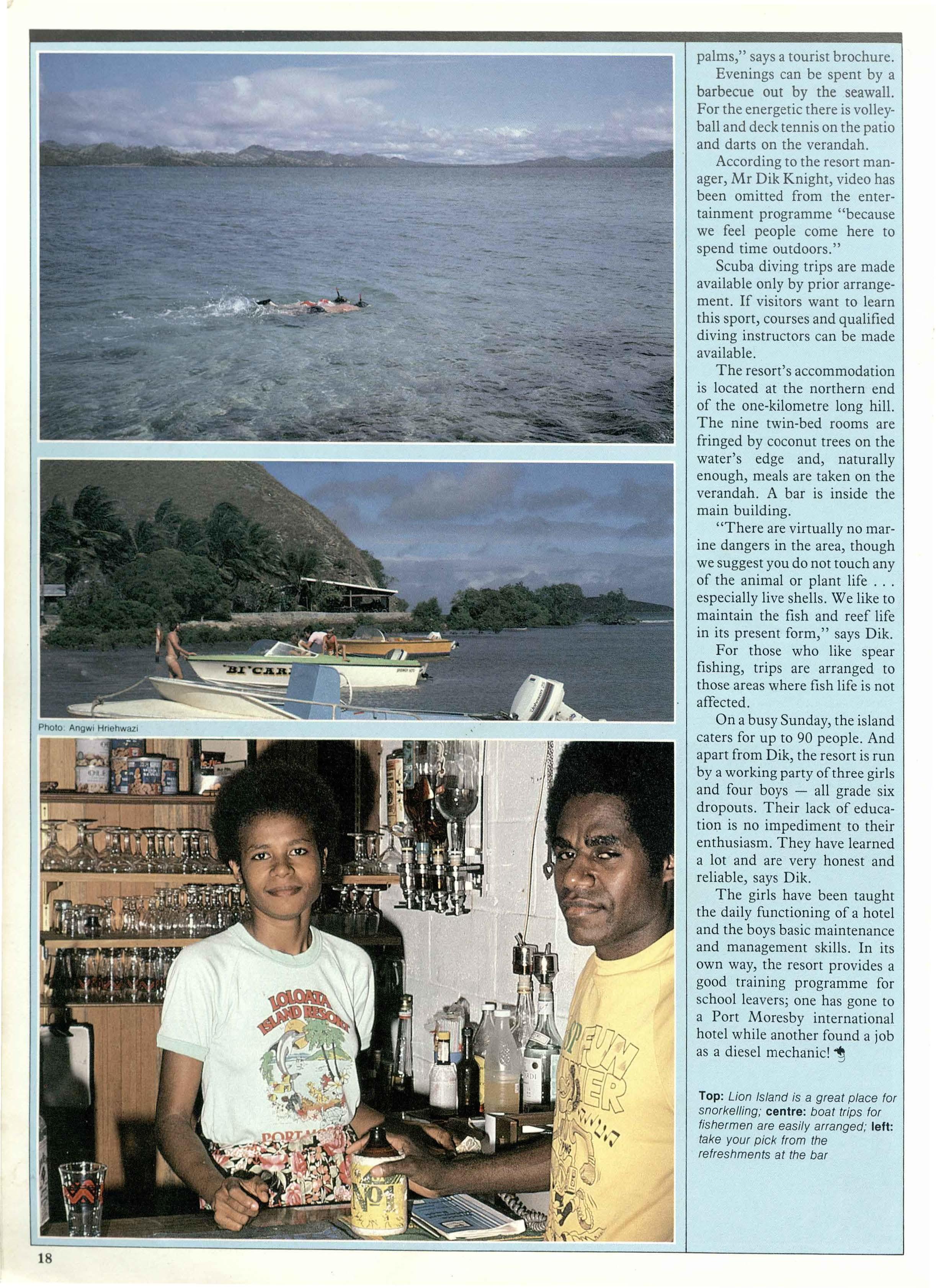
palms," says a tourist brochure.
Evenings can be spent by a barbecue out by the seawall. For the energetic there is volleyball and deck tennis on the patio and darts on the verandah.
According to the resort manager, Mr Dik Knight, video has been omitted from the entertainment programme "because we feel people come here to spend time outdoors."
Scuba diving trips are made available only by prior arrangement. If visitors want to learn this sport, courses and qualified diving instructors can be made available.
The resort's accommodation is located at the northern end of the one-kilometre long hill. The nine twin-bed rooms are fringed by coconut trees on the water's edge and, naturally enough, meals are taken on the verandah. A bar is inside the main building.
"There are virtually no marine dangers in the area, though we suggest you do not touch any of the animal or plant life especially live shells. We like to maintain the fish and reef life in its present form," says Dik. For those who like spear fishing, trips are arranged to those areas where fish life is not affected.
On a busy Sunday, the island caters for up to 90 people. And apart from Dik, the resort is run by a working party of three girls and four boys - all grade six dropouts. Their lack of education is no impediment to their enthusiasm. They have learned a lot and are very honest and reliable, says Dik.
The girls have been taught the daily functioning of a hotel and the boys basic maintenance and management skills. In its own way, the resort provides a good training programme for school leavers; one has gone to a Port Moresby international hotel while another found a job as a diesel mechanic!

We are now linked to the most sophisticated computerised reservation system in the world. Our staff have been professionally trained by Qantas and Air Niugini. At the touch of a button we can book your flight to anywhere in Papua New Guinea or overseas.
Reservations for car hire, accommodation and tours are just part of our magnificent service - and it costs you no more. Give us a call.



THE man in the bar of the Travelodge was an overseas visitor, a businessman, who had visited· Papua New Guinea on many previous occasions. In stentorian tones he proclaimed that Port Moresby was boring, absolutely boring.
I took umbrage at the remark. After 750 days in the city, I told him, I thought I was better qualified to comment than was he.
"Sogeri", I fired ·at him, "Varirata, Moitaka, Koki, Brown River".
"What?" He looked pained.

Looking out towards Port Moresby from Varirata
I wasn't surprised.
"Haven't you visited them yet?"
The look on his face answered.
And so began a lecture which brought home not only to our visitor but to the other local residents at the bar just how much there is to do in Port Moresby.
"I admit Port Moresby's not Sydney or Hong Kong, but it does have a character of its own", I told the visitor.
"Okay," he admitted, I agree
with that. But what are these names you threw at me?"
Sogeri, I explained is some thirty kilometres from Port Moresby set in the Astrolabe Range. The climate is cool, the grass green and the views superb. It is an area where much of the foodstuffs which find their way into the city are grown. Adjacent to Sogeri is Varirata National Park, a peaceful area established for the people of Papua New Guinea to enjoy barbecues, picnicking or bush walking, and where, if you ar-
rive early enough in the morning, Birds of Paradise can be seen in the trees.
"And about 15 kilometres further along the same road to Sogeri and Varirata you'll find Crystal Rapids, where the water cascades over rocky waterfalls and is cool all year round".
I reminded the visitor that rental cars were always available. Brown River is, as the name suggests, another spot worth driving to for a swim on a hot summer's day and could be found, I told him, on any map of Port Moresby and its
environs. "But what of the city", he insisted, "you must admit that's dull!"
"On the contrary", I responded. "You look fit enough to try wind-surfing. Why not take a walk down to Ela Beach tomorrow and hire a boardthey're cheap and available and you'll find plenty of people prepared to help you learn.
"And if you'd rather watch sport than participate, there's always the greatest game of all to watch".
He smiled cynically "I don't like rugby union or soccer", he said victoriously.

"I wasn't thinking of these, though they're popular. To the players of any type of football their code's always the greatest. Rugby League is played every Sunday in the season and draws big crowds, as does Australian Rules".
"I'm from Melbourne", he said as if that answered everyth ing.
"Then you'll appreciate the Yacht Club", I remarked, although the relevance was doubtful. "It's the repose of a peculiar breed of very amiable people. It's a private club, but a phone call to the manager or
commodore is all you need to have a member sign you in. You can have a beer, view the harbour and enjoy an excellent lunch or dinner, any day except Sunday."
Our visitor tried to interrupt but I was in full charge now.

Left: enjoying a leisurely round at the Port Moresby Golf Club; below: race meetings at Bomana Turf Club always attract large crowds; bottom: Rugby League - the greatest game of all - has the largest following of any spectator sport in PNG
"Life in Port Moresby is built to a large extent around the club atmosphere. For flyer's there's the local Aero Club at Jackson's Airport; if you're a car enthusiast the Car Club is on Waigani Drive. The Port Moresby Clay Target Club, Pistol Club and Small Bore Rifle Club have friendly compeuuons each Saturday afternoon, from one till five with standards up to ISU competition - and, of course, they have a beer afterwards. You can find them on Waigani Drive, on the way to the University." "Golf, horse racing". The
visitor had turned the conversation into a "beat you this time" competition.
"The Port Moresby Golf Club is a real test of the game," I countered. "The course is long and tricky with the game you play depend,ing upon the time of year. In the 'wet' you can force the ball onto the green but in the 'dry' it's pitch and run time - and with reasonable green fees there's no excuse for not trying your hand.
"As for horse racing the Port Moresby Turf Club's season runs from around March to November. It's a good country

meeting. There aren't that many horses or jockeys but there's plenty of enthusiasm for the spectators. Betting is the oncourse system; if you win you collect - if you're second or third you don't".
"Cricket, jogging, tennis, squash, diving, snorkelling, sky-diving, bowling ?"
"You forgot tame seals". I had to keep him on the defensive.
"I didn't know you had any".
"Sea Park and the underwater Aquarium are at the end of Ela Beach," I told him. "Maybe not San Diego standard, but still well worth while seeing. The other sports? You'll find that they're all available, depending simply on the season and whether you want to check the phone book for contact numbers - except for snorkelling. Try Idler's Bay; a half-hour's drive from Moresby, to the west. The reef really is fabulous".
"Okay, okay", he said with 'the look of defeat in his eyes, _"but what about culture there isn't any, is there?"

"Philistine!" I said sharply. "When was the last time you took a tour of the artifact shops and saw just how fascinating they are? When did you last visit the National museum? Have you every visited Koki Market and captured some of those superb faces on film?
"And when did you visit the Botanical Gardens at the University? Flowers of one kind or another are in bloom all year round".
"And the University? One of the best in the South Pacific.
"The new Parliament House at Waigani? That's Papua New Guinea's answer to the Sydney Opera House. Some view it's like a huge haus tambaran. In some other ways, the roofs like a canoe sail. And the decor's dinkum traditional stuff''.
"You're exaggerating", he accused.
"See for yourself', I remarked. "And before you accuse me of talking of places and not people, check the local papers for theatre activities. There are two groups who are very active - the National Theatre Company and Dance Group, who
have regular performances at the National Arts School in Waigani, and the Port Moresby Theatre Group. They invariably have plays running at the Waigani Arts Centre. You'll be surprised at the high standard.
"Night descends on Port Moresby in a blaze of magnificence, the incarnadine sky a reflection of God's "
"Cut it out Shakespeare", he barked. "Tell me about the night life then!"
"I will, I will", I promised, gathering my thoughts around me. "The main hotels all have excellent menus, there are at least six Chinese restaurants, the Galley restaurant at the Aviat Club is a delightful setting - in fact you can eat very well indeed in Port Moresby".
"On Fridays and Saturdays you'll find disco's at the hotels. An increasing number of overseas artists are being retained by the Travelodge and the Islander. If you want to see a movieWards Theatre and the Skyline drive-in at Waigani receive international releases surprisingly quickly and ... " "Stop, stop", he pleaded.
Research station. A sight not to be missed
"But I haven't finished", I protested. "You know, I have a theory that boredom is the refuge for those who choose to do nothing".
When he spoke I could see his anguish. "I've been sitting in this hotel for five days now and I've done nothing - and tomorrow I go home!" he admitted. "If only I'd met you before".
"Ask the staff, ask the local residents, check the phone book, the newspapers", I told him, "and all could have been revealed".
He trudged away dejected. I felt the same way. I'd forgotten to mention the speedway at Moitaka.1

AN ECHOFROMTHE PASfBUf AS MODERNASTHE FUIURE
FROM the window of an aeroplane it appears as a vast green carpet, blanketing the earth; from a winding road it seems an impenetrable tangle of vegetation, unwelcoming and unkind; but to those visitors who venture within its boundaries, they discover that the tropical rainforest is a beaut-
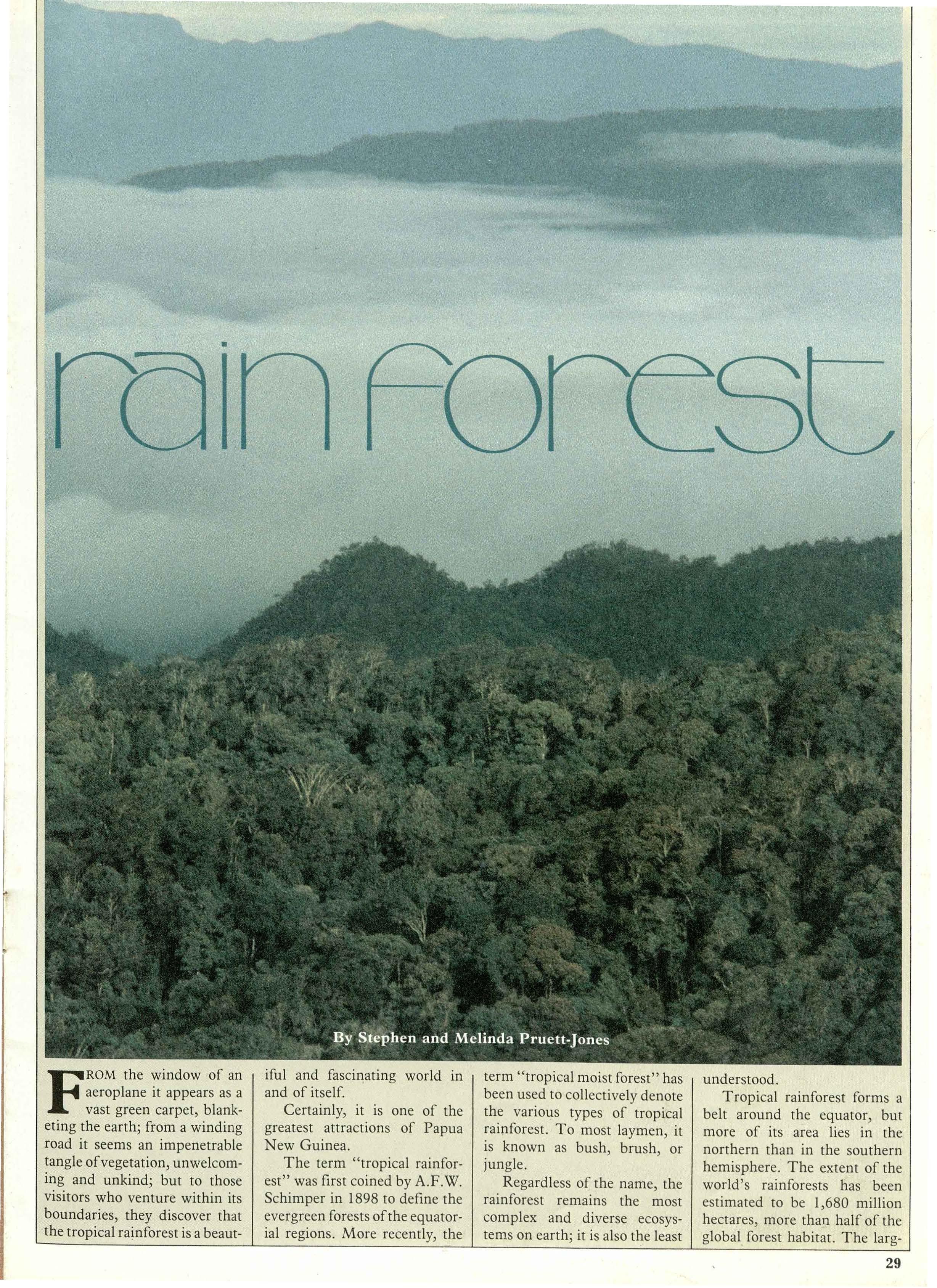
iful and fascinating world in and of itself.
Certainly, it is one of the greatest attractions of Papua New Guinea.
The term "tropical rainforest" was first coined by A.F.W. Schimper in 1898 to define the evergreen forests of the equatorial regions. More recently, the
term "tropical moist forest" has been used to collectively denote the various types of tropical rainforest. To most laymen, it is known as bush, brush, or jungle.
Regardless of the name, the rainforest remains the most complex and diverse ecosystems on earth; it is also the least
understood.
Tropical rainforest forms a belt around the equator, but more of its area lies in the northern than in the southern hemisphere. The extent of the world's rainforests has been estimated to be 1,680 million hectares, more than half of the global_forest habitat. The larg-

est tract is found in the New World, in the basin of the Amazon River. In the ea tern tropics, rainforest extend from Sri Lanka and western India to Thailand, Indo China and the Philippine , and through the Malay Archipelago to New Guinea and the eastern coast of Australia.
The Oora of New Guinea is clo ely related to that of Indone ia and the Male ia region. It has been estimated that more than 9000 pecies of tree and Oowering plant occur on New Guinea. And more than 80 per cent of these species are found nowhere else in the world.
The numbers of trees in rainfore t are staggering even on a local scale. For instance, in one hectare of forest, there is u ually more than 600 tree of about 130 species. Approximately half of these trees would reach the top of the forest canopy, generally 25-40 metres high. Below the canopy both light inten ity and temperature are reduced, conditions that require special adaptations by smaller trees.
Tropical rainfore ts appear as a bewildering chaos of vegetation, but they have a definite structure. It i often remarked that in such forests, nature shows a horror vacui - that is, it is anxious to fill every space with stems and leaves. Trees in the rainforest are arranged in three strata, or stories: the dominant canopy layer above, a complete mid-canopy, and a lower scattered layer of trees. Below this there is an understorey of low herbs and shrubs.
The number of animals that live in the forest is far less than that of the plants. A little over 700 species of birds regularly occur on New Guinea, and about half this number of either mammals, reptiles, and amphibians.
It is suspected that nearly I 0 to 20 animals, mostly reptiles and amphibians, have yet to be discovered within the forest of ew Guinea.
Insects are by far the most abundant organisms on the island, both within and outside the forests.
Typically, about 100-125 species of birds and about 20 species of mammals may be
found in a given area. As with trees, the number of species of animals in the forest drops off with increasing altitude. At 3000 metres altitude, there may be only one-tenth of the number of species of birds and mammals which occur near sea level. The majority of animals, as well as plants, are restricted to certain altitudinal limits and very few occur over all habitats or across all mountain zones.
The complex interplay between plants and animals in the tropical rainforest is a fascinating puzzle.
To illustrate, one of the most interesting relationships concerns the fruit trees and the animals that depend on them. The majority of rainforest trees on New Guinea produce fruit, which is eaten by birds, bats, and various terrestrial mammals. These animals depend on the trees' fruit for food, and the trees depend on the animals to carry the seeds of the fruit some distance from the parent tree. This is part of a process termed dispersal.
On New Guinea, trees appear to cater to the particular
Far left: a look inside the mid-montane rainforest at an altitude of 1,700 metres: left: Albizia trees, which occur as emergents above the forest canopy; below left: the luxuriant upper montane rainforest, at 2,000 metres altitude; below centre: the dense and luxuriant lowland rainforest, where rivers often are the only path for easy travel; below right: above 2,000 metres altitude, much of the forest is covered in heavy moss

needs of the animals that eat their fruit.
Fruits eaten by birds are bright in colour, nutritious and they have small seeds which are passed or dropped once that birds have digested the fruit.
Fruits eaten by bats are usually white (to be seen at night), very watery, and less nutritious.
Those fruits eaten by mammals are dark in colour, tend to ripen on the ground after they fall, and some have very large,

strong seeds which are not broken up when swallowed.
The island of New Guinea, more than 900,000 square kilometres in size, has more than 75 per cent of its surface covered by forest. This is one of the largest tracts of rainforest in the eastern tropics and it remains relatively undisturbed and largely intact.
In many areas, however, the forest has been greatly changed or even removed as a result of man's activities. Subsistence, slash-and-burn agriculture has been a historical factor, converting large areas of forest into grassland. Even greater threats are posed by large-scale agricultural developments, logging, and mining efforts.
Once thought to be limitless and tractless, the tropical rainforests are now disappearing worldwide at the rate of21 hectares every minute of every day. In many ways, we cannot afford to lose this valuable resource.
The tropical rainforest is a source of timber, food, new medicines, and is home for the majority of animals on the earth.
The second half of the 20th century may stand in history as the brief period during which man reduced this richest and most vital ecosystem by about one half. The present rate of destruction is so rapid that, unless efforts are made to preserve them, the rainforests of the world will completely disappear sometime soon after the turn of the century. This would have unforeseen, and many believe disastrous, biological and economic consequences.
It is encouraging that the government of Papua New Guinea has a protective policy concerning its forests.
But should you get an opportunity to view the rainforest from the inside, be sure not to pass it up. It could be the chance of your lifetime - and the forests's - to view one of the most wondrous spectacles on earth.~
Crisp, clean and elegant. Thoroughly Mazda, and thoroughly functional.
Mazda 929's low front nose and smooth, wedge-shaped body have resulted in splendid aerodynamics without compromising interior spaciousness.
A low cowl point, and six light windows increase visibility while producing an open, airier feeling for passengers. Also note the low profile windscreen wipers, smooth body joints, and flat, aerodynamic wheel covers.

Mazda believes a car should be fun to drive. Here, handling capabilities help to make it so.
The Mazda 929 is equipped to deliver handling that's nothing short of gratifying in virtually every important category.
Front suspension is strut-type, and incorporates small scrub geometry and higher castor angles for improved straight-line braking without compromising cornering performance. Semi-trailing independent rear suspension brings you a ride that's as smooth as it is responsive.
Mazda 929 also gives you highspeed stability and low-speed manoeuvrability with variable ratio rack & pinion steering.
In Mazda 929, comfort begins with ride. Sophisticated suspension design, along with tapered coil springs and the extensive use of directional bushings help to flatten out tough roads.
Seat design is also of vast importance. The 929's seats are wide and comfortableergonomically designed for excellent body support exactly where it's needed. Dual recline helps to asure comfort for any body type.
A flow-through ventilation system permits you to maintain a fresh cabin environment. Mazda has also reduced noise and vibration to a point where they won't infringe on your driving comfort.
Mazda 929's quality meets the eye in the form of precise exterior fit and finish, and a mirror-smooth paint job. But the quality goes much deeper. Mazda 929's body has been subjected to a cathodic electro-coating process that rejects corrosion. The use of thicker paint and galvanized steel body parts add to the 929's anticorrosion measures.
Mazda 929, in terms of design and production, reflects the best i;if today's automotive art. And the result is a high level of quality engineering that is typically Mazda's.
In business, investment, foreign exchange and trade, the success of any organisation depends upon its ability to take advantage of opportunities when they present themselves - speed is the essence.
To take advantage of such opportunities, you need a bank which is a real partner - a bank with a presence in all major international markets.
Banque Indosuez is present in

world wide banking network, Indosuez Niugini plays a vital role by offering Papua New Guinea business and commercial communities immediate access to international banking, communication lines and exposure to international and financial opportunities.
Indosuez Niugini Bank has a very wide door,a door that opens on to the world,a world of foreign exchange, more than 55 countries.
By joining
a world of finance
and a world of opportunities. this
lndosuez Niugini Bank Ltd. Burns House Champion Parade PO Box 1390, Port Moresby, Papua New Guinea. Telephone: 21 3533 Telex: 23274 INDONIU
''LIKE every marathon you've ever run" proclaims the advertising. But it is not mere salesmanship and gimmickryPort Moresby stages an event with a difference. The Air Niugini-PNG Motors International Marathon, together with the Hebamo Half Marathon, are races that contestants never forget.
Never before has the Boroko town centre been alive in the· early hours of Sunday morning as it was on the 26thJune 1983. The darkness was enlivened by the nervous anticipation of almost 200 runners, the quiet efficiency of the busy officials

clustered around hurricane lamps on portable tables and the excitement of still-yawning spectators.
It was an eerie scene beneath Boroko's only light as halfnaked runners jogged off into the enveloping gloom to warm up, or pushed against apparently invisible objects to stretch muscles. Police motorcyclists with blue flashing lights and the crackle of walkie-talkies added to the extra-terrestrial effects.
For those participating, concern was more for the barometer than their surroundings. Light rain the previous evening ha1 kept the temperat-
ure and humidity high, and hopes for conditions similar to the previous year were quietly dashed. It is in an effort to avoid the devastating effects of heat and humidity that Moresby's marathon starts at 5 am with a third of the event being raced in almost total darkness. Such a novelty may not encourage the runner who wishes to take in the sights as he pounds along but it does ensure concentration is at a maximum.
As the clock moved towards 5 am, timekeepers and starters gave last-minute instructions, runners moved to the line, police started their machines, the humidity remained at 94% and
the temperature edged up to 24 degrees celsius. It was going to be a warm race.
Three times winner of the event, and Papua New Guinea marathon record holder at 2 hours 28 minutres 13 seconds (set in the 1980 Honolulu Marathon), Tau John Tokwepota was aiming to better 2 hours 25 minutes. The conditions did not augur well for the attempt, but his preparation of 130 km per week over the previous three months ensured that he was at peak fitness.
From the crack of the starting pistol Tokwepota went to the front and as the field of 90 turned down Angau Drive he

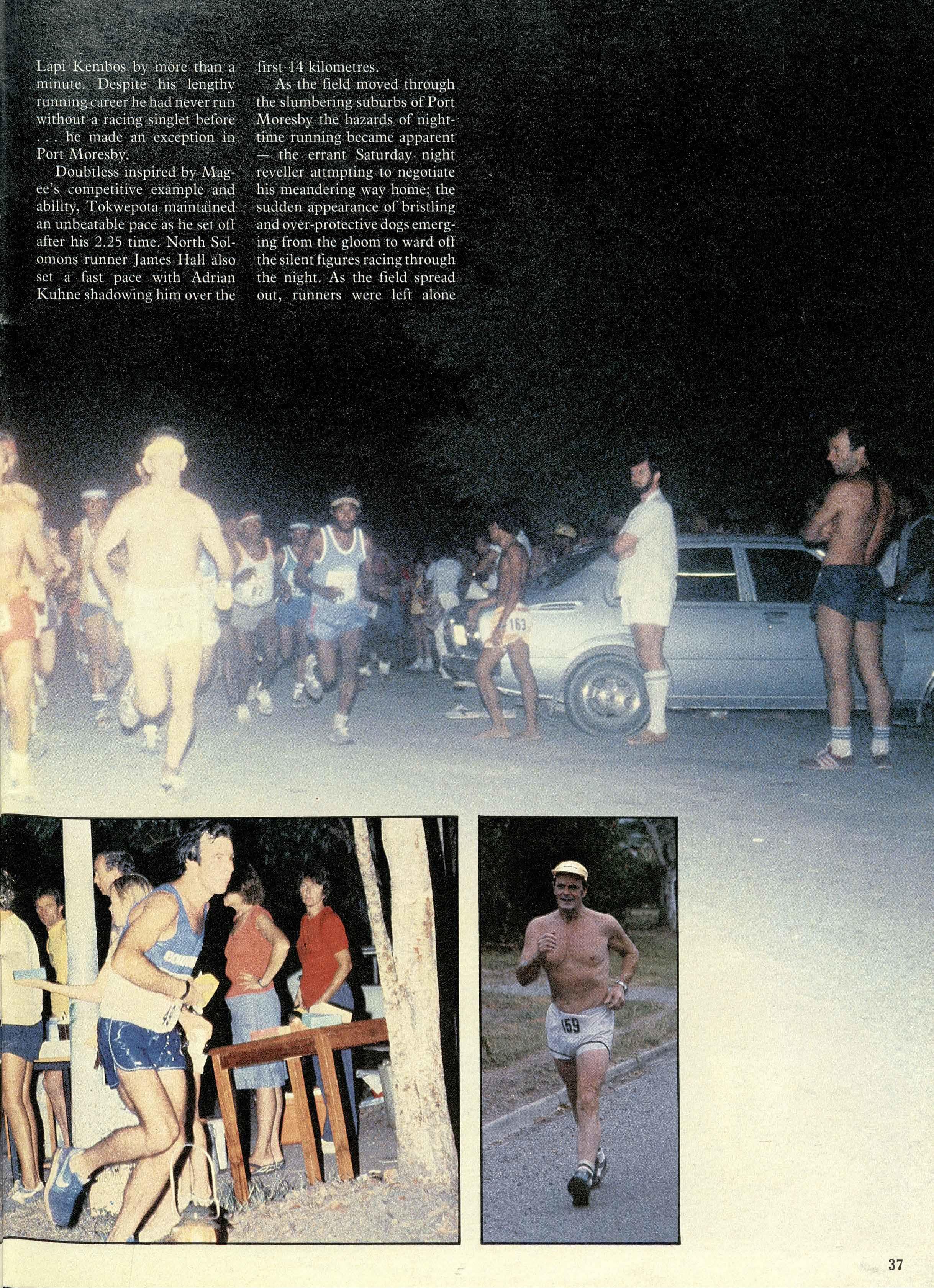
with their pace and their thoughts, unable to pick out the markings of a sometimes unfamiliar course. The odd potholes, ditches and corrugations, not to mention the chains and gates through the university grounds, add interest, as does the occasional thought of a nocturnal snake or two.
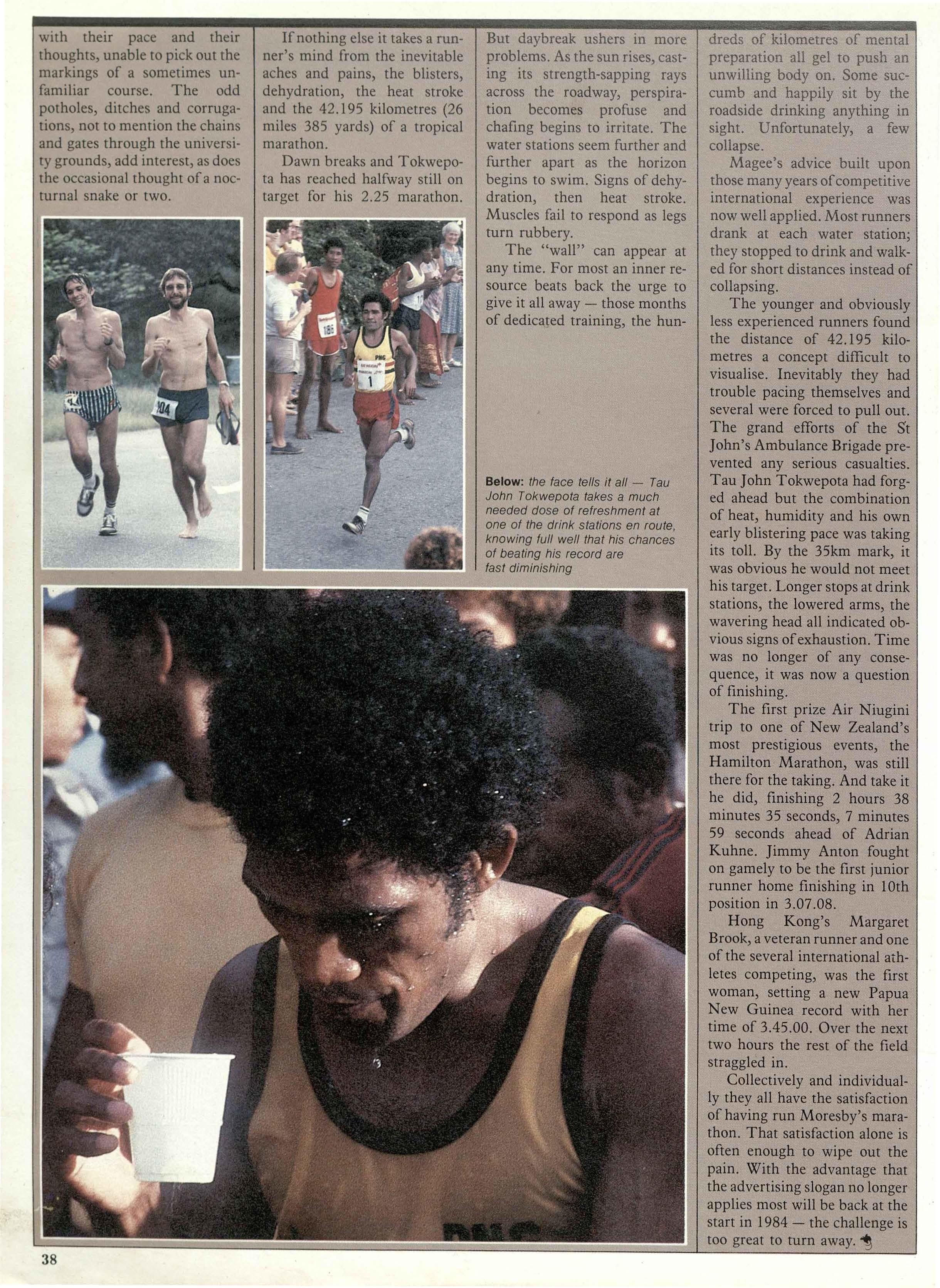
If nothing else it takes a runner's mind from the inevitable aches and pains, the blisters, dehydration, the heat stroke and the 42.195 kilometres (26 miles 385 yards) of a tropical marathon.
Dawn breaks and Tokwepota has reached halfway still on target for his 2.25 marathon.
But daybreak ushers in more problems. As the sun rises, casting its strength-sapping rays across the roadway, perspiration becomes profuse and chafing begins to irritate. The water stations seem further and further apart as the horizon begins to swim. Signs of dehydration, then heat stroke. Muscles fail to respond as legs turn rubbery.
The "wall" can appear at any time. For most an inner resource beats back the urge to give it all away - those months of dedicated training, the hun-
dreds of kilometres of mental preparation all gel to push an unwilling body on. Some succumb and happily sit by the roadside drinking anything in sight. Unfortunately, a few collapse.
Magee's advice built upon those many years of competitive international experience was now well applied. Most runners drank at each water station; they stopped to drink and walked for short distances instead of collapsing.
Below: the face tells it all - Tau John Tokwepota takes a much needed dose of refreshment at one of the drink stations en route, knowing full well that his chances of beating his record are fast diminishing
The younger and obviously less experienced runners found the distance of 42.195 kilometres a concept difficult to visualise. Inevitably they had trouble pacing themselves and several were forced to pull out. The grand efforts of the St John's Ambulance Brigade prevented any serious casualties. Tau John Tokwepota had forged ahead but the combination of heat, humidity and his own early blistering pace was taking its toll. By the 35km mark, it was obvious he would not meet his target. Longer stops at drink stations, the lowered arms, the wavering head all indicated obvious signs of exhaustion. Time was no longer of any consequence, it was now a question of finishing.
The first prize Air Niugini trip to one of New Zealand's most prestigious events, the Hamilton Marathon, was still there for the taking. And take it he did, finishing 2 hours 38 minutes 35 seconds, 7 minutes 59 seconds ahead of Adrian Kuhne. Jimmy Anton fought on gamely to be the first junior runner home finishing in 10th position in 3.07.08.
Hong Kong's Margaret Brook, a veteran runner and one of the several international athletes competing, was the first woman, setting a new Papua New Guinea record with her time of 3.45.00. Over the next two hours the rest of the field straggled in.
Collectively and individually they all have the satisfaction of having run Moresby's marathon. That satisfaction alone is often enough to wipe out the pain. With the advantage that the advertising slogan no longer applies most will be back at the start in 1984 - the challenge is too great to turn away.1

You will find the Davara Group the most enjoyable Hotels to stay at when visiting Papua New Guinea. We not only provide an endless summer in which you can enjoy yourself, but, as well, a choice of superb local and international cuisine and top class cabaret entertainment. Our airconditioned bedrooms ensure your good nights rest, so that refreshed, you may enjoy our catamaran cruises or perhaps some energetic water ski-ing or windsurfing. Maybe too, if you are a businessman you should consider our well appointed function rooms and facilities for that conference or special presentation. And during your stay you'll be pampered with traditional Melanesian friendliness and service. So stay in paradise - stay with us!
It's easy to understand why.
After all,Australia is the world'slargest holidayisland. Just mileafter endlessmileof sunbleachedbeaches, tropicalrainforests and snow-capped mountains.
It's difficultto imagineever wanting to spend a holidayanywhereelse. Most Australianscertainly don'tseem to bother. And certainly no airlinefeels more at home there than Ansett.
With our associate airlineswe covermore of Australiathan anybody else. , And ourjet services ;·;_to majorAustraµan '. 1;. • ports connectwith all internationalflights. So, why don'tyou ••·_:; ·: see Australiathe same way more Australians prefer to see it? On any oneof the countlessAnsett low-priced packaged holidays.Forfurther informationand a copyof Ansett'sAustralia

Every year moreand more AustraliansflyAnsett for their holidaysthan any otherairline.